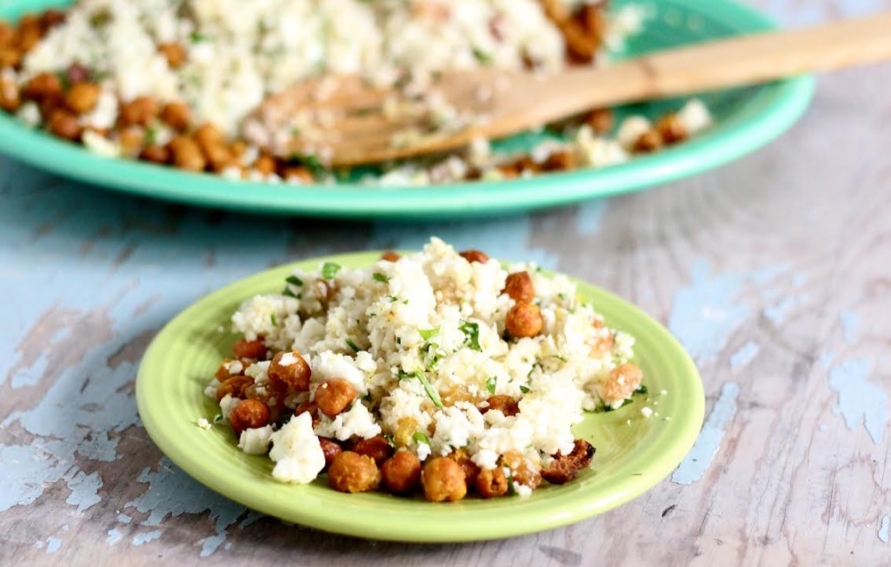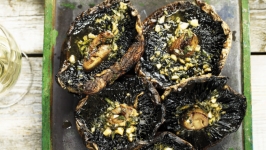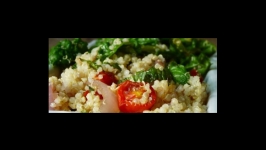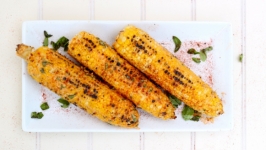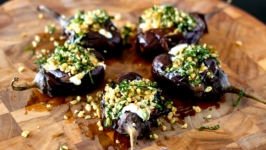Ingredients
- 1 large head cauliflower, broken into florets (about 5 cups)
- ¼ cup extra virgin olive oil or coconut oil
- 2 large shallots, minced
- 1 clove garlic, minced
- ¼ teaspoon allspice
- ½ cup golden raisins
- ¼ cup parsley, finely chopped
- Zest of 1 lemon, plus 1 tablespoon juice
- Salt and freshly ground pepper
- Roasted Chickpeas (see below)
- 2½ cups cooked garbanzo beans, rinsed
- 2 tablespoons extra virgin oil
- ½ teaspoon ground turmeric
- Coarse salt
About this recipe
*Key Components*
Cauliflower is high in antioxidants and has cancer-fighting powers. Like its cousin, cabbage, it contains a hefty amount of glucosinolates (an organic compound containing sulfur), which are the reason for their pungent smell but also why they’re so good for you! A lot of the vital nutrients and compounds found in cauliflower are lost during transportation and storage, so this is a great vegetable to seek out locally. It’s typically available in Sarasota during winter and spring. Cauliflower is also one of those vegetables that loses nutrients the longer it’s cooked, especially when boiled or blanched. But don’t worry, I’ve taken that into consideration when writing this recipe.
Shallots are in the allium family with garlic and onions. They are a powerful bunch, shallots being one of the best cancer-fighters out there. In fact, they have six times more phytonutrients than a typical onion (not to say onions aren’t loaded with them — they certainly are). Phytonutrients are natural chemicals in plants that help protect the plant from environmental threats. What’s really is cool is that when we eat plants loaded with these phytonutrients, they help to protect us from disease too!
Allspice comes from the dried berry of a pepper tree native to tropical climates. There is no heat to this spice, but like most spices, it is very good for you. I like to use a lot of dried, ground spices in my cooking because of the concentration of beneficial properties, from being anti-inflammatory to packing a punch of minerals and vitamins. Plus they add layers of flavor that wake up your taste buds.
Chickpeas (or garbanzo beans) are so good for you that listing all the benefits would make this post entirely too long. I will tell you that they are a great source of protein, fiber, and iron. They help balance blood sugar and are particularly helpful for postmenopausal women, helping to minimize hot flashes and protecting against breast cancer and osteoporosis. And here’s some really great news: Canned beans are even better for you than soaking and cooking your own! What?! The heat of the canning process enhances the antioxidant power. Just be sure to buy an organic brand, preferably in a pouch or box versus an actual can to avoid BPA exposure.
Instructions
First, get the chickpeas going in the oven:
- Heat oven to 400°. Line a large, rimmed baking sheet with paper towels, spread beans on towels, and blot dry. Removing moisture helps the beans get really crispy. Discard paper towels.
- Use your hands to toss beans with olive oil, turmeric, and salt to taste. Roast until crispy and browned, 35–45 minutes, shaking the pan occasionally.
To prepare the couscous:
- Transfer half the cauliflower florets to the bowl of a food processor. Pulse rapidly until it resembles couscous. Do not over-process or it will turn to mush. Transfer to a bowl and repeat with remaining cauliflower.
- Combine oil, shallots, and garlic in large, nonstick (see note #1) skillet over low heat. Cook until garlic is fragrant and shallots soften, about 5 minutes. Add allspice and raisins and cook until warmed through and raisins plump.
- Add cauliflower "couscous," parsley, lemon zest, and juice. Season with salt and pepper, and toss until thoroughly combined and warmed through. I like to leave the cauliflower on the raw side, but you can cook it longer if you prefer. Serve topped with roasted chickpeas.
*Notes:
1. Great nonstick skillet choices include a well-seasoned cast iron skillet, or do a little research and find a nonstick skillet that in also nontoxic -- they're out there.
2. If you don't have allspice in the house, don't buy it just for this recipe. Try using a pinch of cinnamon or cloves instead.
3. Make sure to buy organic raisins and check the ingredients if you are avoiding sulfur dioxide (a sulfite preservative) found in most dried fruits. Or try chopping up some fresh grapes to replace the raisins in this recipe.

